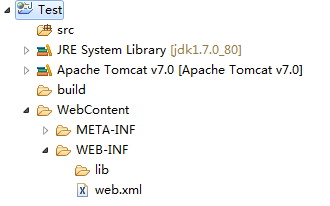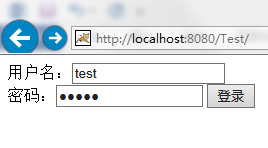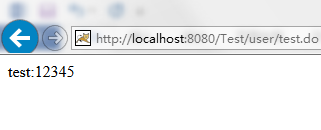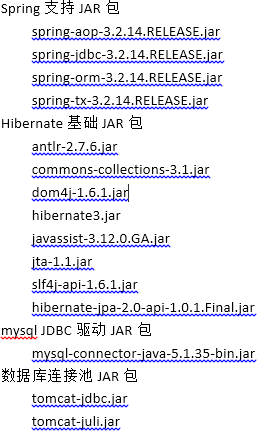SpringMVC + Spring 3.2.14 + Hibernate 3.6.10 集成详解
注:此文档只说明简单的框架集成,各个框架的高级特性未涉及,刚刚接触框架的新人可能需要参考其他资料。
PS:本次练习所用jar包都能在此下载到:http://pan.baidu.com/s/1sjmgdYX
- 准备工作
开发环境:JDK 7u80、Eclipse 4.4 、Tomcat 7.0.63、MySQL 5.6
开发使用组件:Spring 3.2.14、Hibernate 3.6.10、common-logging 1.2、aopalliance.jar、aspectjweaver.jar、mysql-connector-java-5.1.35-bin.jar
在Eclipse下创建动态web项目Test,创建过程中注意勾选web.xml的选项,如果不勾选,项目创建之后需要手动创建web.xml,创建完成后将其部署到Tomcat中,项目结构应该如下(Package Explorer下,看个人习惯):

- 配置Spring
将以下JAR包复制到lib文件夹下,不要问为什么是这些,想知道为什么可以把其他任意一个删掉看看启动项目报什么错。

在web.xml中配置Spring监听器,代码如下:
<listener>
<listener-class>org.springframework.web.context.ContextLoaderListener</listener-class>
</listener>
创建applicationContext.xml,当前版本的Spring默认其位于WEB-INF下,不过大多数开发人员习惯还是将其放到src下,这里我们将其放在src下。之后向applicationContext.xml中添加bean相关声明,具体如下
<?xml version="1.0" encoding="UTF-8"?>
<beans xmlns="http://www.springframework.org/schema/beans"
xmlns:xsi="http://www.w3.org/2001/XMLSchema-instance"
xsi:schemaLocation="http://www.springframework.org/schema/beans
http://www.springframework.org/schema/beans/spring-beans-3.2.xsd">
</beans>
web.xml中添加如下内容,用于自定义Spring配置文件的位置:
<context-param>
<param-name>contextConfigLocation</param-name>
<param-value>classpath:applicationContext.xml</param-value>
</context-param>
新建测试实体类User,路径暂定为com.test.entity,添加如下代码:
package com.test.entity;
public class User {
private String id;
private String username;
private String password;
public String getId() {
return id;
}
public void setId(String id) {
this.id = id;
}
public String getUsername() {
return username;
}
public void setUsername(String username) {
this.username = username;
}
public String getPassword() {
return password;
}
public void setPassword(String password) {
this.password = password;
}
}
applicationContext.xml中添加如下定义(此处测试完成之后可以删除):
<bean id="user" class="com.test.entity.User">
<property name="username" value="test" />
</bean>
新建Test类,暂定路径com.test.test,添加如下代码:
package com.test.test;
import org.springframework.context.support.FileSystemXmlApplicationContext;
import com.test.entity.User;
public class Test{
@SuppressWarnings("resource")
public static void main(String[] args) {
FileSystemXmlApplicationContext ac =
new FileSystemXmlApplicationContext("src\\applicationContext.xml");
User user = (User) ac.getBean("user");
System.out.println(user.getUsername());
}
}
运行Test类查看结果,如果输出test则表示spring框架运行正常。
- 配置SpringMVC
添加SpringMVC所需JAR包:spring-webmvc-3.2.14.RELEASE.jar,在web.xml中添加SpringMVC前端控制器相关配置,SpringMVC的配置文件默认servlet配置名-servlet.xml(例如此处应该为springmvc-servlet.xml),位于WEB-INF下,这里我们将spring的配置文件与springmvc配置文件合并,所以我们需要在配置DispatcherServlet时说明配置文件的位置,配置如下:
<servlet>
<servlet-name>springmvc</servlet-name>
<servlet-class>org.springframework.web.servlet.DispatcherServlet</servlet-class>
<init-param>
<param-name>contextConfigLocation</param-name>
<param-value>classpath:applicationContext.xml</param-value>
</init-param>
<load-on-startup>1</load-on-startup>
</servlet>
<servlet-mapping>
<servlet-name>springmvc</servlet-name>
<url-pattern>*.do</url-pattern>
</servlet-mapping>
配置springmvc扫描器,用于扫描springmvc注解,此处需要用到context标签, 所以需要添加context的文档声明,所有代码如下:
<?xml version="1.0" encoding="UTF-8"?>
<beans xmlns="http://www.springframework.org/schema/beans"
xmlns:xsi="http://www.w3.org/2001/XMLSchema-instance"
xmlns:context="http://www.springframework.org/schema/context"
xsi:schemaLocation="http://www.springframework.org/schema/beans
http://www.springframework.org/schema/beans/spring-beans-3.2.xsd
http://www.springframework.org/schema/context
http://www.springframework.org/schema/context/spring-context-3.2.xsd">
<context:component-scan base-package="com.test" />
<bean id="user" class="com.test.entity.User">
<property name="username" value="test" />
</bean>
</beans>
配置视图解析器,Controller层处理完请求之后会返回数据或者视图,所以我们需要先添加视图解析器,否则无法跳转回前台页面,代码如下:
<bean class="org.springframework.web.servlet.view.InternalResourceViewResolver">
<property name="suffix" value=".jsp"/>
</bean>
- 测试SpringMVC
创建index.jsp,代码如下:
<%@ page language="java" contentType="text/html; charset=UTF-8" pageEncoding="UTF-8"%>
<!DOCTYPE html PUBLIC "-//W3C//DTD HTML 4.01 Transitional//EN" "http://www.w3.org/TR/html4/loose.dtd">
<html>
<head>
<meta http-equiv="Content-Type" content="text/html; charset=UTF-8">
<title>test</title>
</head>
<body>
<form action="${pageContext.request.contextPath }/user/test.do" method="post">
<label>用户名:</label><input type="text" name="username" /><br>
<label>密码:</label><input type="password" name="password" />
<input type="submit" value="登录">
</form>
</body>
</html>
创建return.jsp,代码如下:
<%@ page language="java" contentType="text/html; charset=UTF-8" pageEncoding="UTF-8"%>
<!DOCTYPE html PUBLIC "-//W3C//DTD HTML 4.01 Transitional//EN" "http://www.w3.org/TR/html4/loose.dtd">
<html>
<head>
<meta http-equiv="Content-Type" content="text/html; charset=UTF-8">
<title>test</title>
</head>
<body>
${user.username }:${user.password }
</body>
</html>
创建UserController,暂定位于com.test.controller,用于接收前台请求,代码如下:
package com.test.controller;
import org.springframework.beans.factory.annotation.Autowired;
import org.springframework.stereotype.Controller;
import org.springframework.ui.ModelMap;
import org.springframework.web.bind.annotation.RequestMapping;
import com.test.entity.User;
import com.test.service.UserService;
@Controller
@RequestMapping("/user")
public class UserController {
@Autowired
private UserService userService;
@RequestMapping("/test")
public String test(User user,ModelMap model){
System.out.println(user.getUsername());
System.out.println(user.getPassword());
model.addAttribute(user);
return "/return";
}
}
启动Tomcat后测试即可,正常情况下结果如下,说明框架已成功相应请求:


- 配置Hibernate集成
添加以下JAR包:

applicationContest.xml中添加Hibernate相关配置,hibernate的实体声明可以选择配置文件和注解两种方式,我个人比较倾向于配置文件方式,如下图所示:
<bean id="dataSource" class="org.apache.tomcat.jdbc.pool.DataSource">
<property name="url" value="jdbc:mysql://localhost:3306/test" />
<property name="driverClassName" value="com.mysql.jdbc.Driver" />
<property name="username" value="root" />
<property name="password" value="root" />
</bean>
<bean id="sessionFactory" class="org.springframework.orm.hibernate3.LocalSessionFactoryBean">
<property name="dataSource" ref="dataSource" />
<property name="mappingLocations">
<value>classpath*:/com/test/entity/*.cfg.xml</value>
</property>
<property name="hibernateProperties">
<props>
<prop key="hibernate.show_sql">true</prop>
</props>
</property>
</bean>
由于Hibernate3必须在事务中处理数据访问,所以需要添加事务控制,个人倾向于使用aop方式,所以需要先添加tx和aop的文档配置,配置后文档声明部分代码如下:
<beans xmlns="http://www.springframework.org/schema/beans"
xmlns:xsi="http://www.w3.org/2001/XMLSchema-instance"
xmlns:context="http://www.springframework.org/schema/context"
xmlns:tx="http://www.springframework.org/schema/tx"
xmlns:aop="http://www.springframework.org/schema/aop"
xsi:schemaLocation="http://www.springframework.org/schema/beans
http://www.springframework.org/schema/beans/spring-beans-3.2.xsd
http://www.springframework.org/schema/context
http://www.springframework.org/schema/context/spring-context-3.2.xsd
http://www.springframework.org/schema/tx
http://www.springframework.org/schema/tx/spring-tx-3.2.xsd
http://www.springframework.org/schema/aop
http://www.springframework.org/schema/aop/spring-aop-3.2.xsd">
配置事务控制器,并通过aop将其织入到service切面进行事务控制,如下所示:
<bean id="txManager" class="org.springframework.orm.hibernate3.HibernateTransactionManager">
<property name="sessionFactory" ref="sessionFactory" />
</bean>
<tx:advice id="txAdvice" transaction-manager="txManager">
<tx:attributes >
<tx:method name="*" propagation="REQUIRED"/>
</tx:attributes>
</tx:advice>
<aop:config>
<aop:pointcut expression="execution(* com.test.service.*.*(..))" id="aopPointcut"/>
<aop:advisor advice-ref="txAdvice" pointcut-ref="aopPointcut"/>
</aop:config>
- 测试整体框架
Mysql中创建test_user表用于测试框架能否正常进行数据库的操作,此处我们测试在事务管理中进行保存操作,建表语句如下:
create table test_user (
id varchar(36) primary key,
username varchar(20) not null,
password varchar(50) not null
);
创建Hibernate实体映射文件,内容如下:
<?xml version="1.0" encoding="UTF-8"?>
<!DOCTYPE hibernate-mapping PUBLIC
"-//Hibernate/Hibernate Mapping DTD 3.0//EN"
"http://www.hibernate.org/dtd/hibernate-mapping-3.0.dtd">
<hibernate-mapping>
<class name="com.test.entity.User" table="test_user">
<id name="id" type="java.lang.String" length="36">
<column name="id" />
<generator class="uuid" />
</id>
<property name="username" type="java.lang.String" length="10" >
<column name="username" not-null="true" unique="true"/>
</property>
<property name="password" type="java.lang.String" length="32" >
<column name="password" not-null="true" unique="true"/>
</property>
</class>
</hibernate-mapping>
创建UserDAO,暂定位于com.test.dao下,用于处理数据库操作,代码如下:
package com.test.dao;
import org.hibernate.SessionFactory;
import org.springframework.beans.factory.annotation.Autowired;
import org.springframework.stereotype.Repository;
import com.test.entity.User;
@Repository
public class UserDAO {
@Autowired
private SessionFactory sessionFactory;
public String save(User user){
return (String) sessionFactory.getCurrentSession().save(user);
}
}
创建UserService,暂定位于com.test.service下,用于提供请求服务,代码如下:
package com.test.service;
import org.springframework.beans.factory.annotation.Autowired;
import org.springframework.stereotype.Service;
import com.test.dao.UserDAO;
import com.test.entity.User;
@Service
public class UserService {
@Autowired
private UserDAO userDAO;
public String save(User user){
return userDAO.save(user);
}
}
修改UserController如下:
package com.test.controller;
import org.springframework.beans.factory.annotation.Autowired;
import org.springframework.stereotype.Controller;
import org.springframework.ui.ModelMap;
import org.springframework.web.bind.annotation.RequestMapping;
import com.test.entity.User;
import com.test.service.UserService;
@Controller
@RequestMapping("/user")
public class UserController {
@Autowired
private UserService userService;
@RequestMapping("/test")
public String test(User user,ModelMap model){
userService.save(user);
model.addAttribute(user);
return "/return";
}
}
至此项目内容应该如下图所示:

重启Tomcat后输入用户名和密码,点击按钮后查看数据库,正常结果为后台未报错且数据库有数据存入,如下图所示:

接下来我们测试下在出现异常的情况下能否正常回滚事务,修改Service代码如下:
package com.test.service;
import org.springframework.beans.factory.annotation.Autowired;
import org.springframework.stereotype.Service;
import com.test.dao.UserDAO;
import com.test.entity.User;
@Service
public class UserService {
@Autowired
private UserDAO userDAO;
public String save(User user){
userDAO.save(user);
throw new RuntimeException("测试事务能否正常回滚!");
}
}
重启Tomcat后测试框架能否正常回滚,正常情况下,后台会将自定义的异常抛出,而数据库中未出现第二条数据,框架集成到此结束,之后便可进行基于框架的开发工作了。
PS:各位有什么问题或者不同看法可以留言







【推荐】国内首个AI IDE,深度理解中文开发场景,立即下载体验Trae
【推荐】编程新体验,更懂你的AI,立即体验豆包MarsCode编程助手
【推荐】抖音旗下AI助手豆包,你的智能百科全书,全免费不限次数
【推荐】轻量又高性能的 SSH 工具 IShell:AI 加持,快人一步
· AI与.NET技术实操系列:向量存储与相似性搜索在 .NET 中的实现
· 基于Microsoft.Extensions.AI核心库实现RAG应用
· Linux系列:如何用heaptrack跟踪.NET程序的非托管内存泄露
· 开发者必知的日志记录最佳实践
· SQL Server 2025 AI相关能力初探
· winform 绘制太阳,地球,月球 运作规律
· AI与.NET技术实操系列(五):向量存储与相似性搜索在 .NET 中的实现
· 超详细:普通电脑也行Windows部署deepseek R1训练数据并当服务器共享给他人
· 【硬核科普】Trae如何「偷看」你的代码?零基础破解AI编程运行原理
· 上周热点回顾(3.3-3.9)
2014-08-03 Spring.NET学习
2014-08-03 Spring.Net+Nhibernate+Asp.Net Mvc 框架
2012-08-03 一张图解读.Net集合类型层级关系
2012-08-03 Node.js入门学习笔记-IDE选择/配置之WebStorm(windows)
2012-08-03 开发人员必须知道的10个跨平台应用解决方案
2012-08-03 设计模式学习之Facade模式
2012-08-03 python 实现文件的递归拷贝